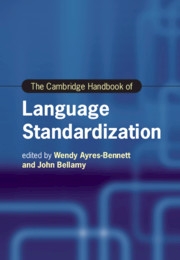Book contents
- The Cambridge Handbook of Language Standardization
- cambridge handbooks in language and linguistics
- The Cambridge Handbook of Language Standardization
- Copyright page
- Contents
- Figures
- Tables
- Contributors
- Introduction
- Part I Revisiting Models and Theories of Language Standardization
- Part II Legitimacy, Authority and the Written Form
- Part III Norms, Literacy and Education
- 14 Language Endangerment and Standardization
- 15 Indigenous Languages, Standardization and Curricular Development
- 16 Polynomic Standards
- 17 Standard Languages and Standardization in the Context of Bilingual Education
- 18 Setting Standards for Language Learning and Assessment in Educational Contexts
- Part IV Beyond the National
- Part V Standardization in Late Modernity
- Name Index
- Subject Index
- References
17 - Standard Languages and Standardization in the Context of Bilingual Education
from Part III - Norms, Literacy and Education
Published online by Cambridge University Press: 01 July 2021
- The Cambridge Handbook of Language Standardization
- cambridge handbooks in language and linguistics
- The Cambridge Handbook of Language Standardization
- Copyright page
- Contents
- Figures
- Tables
- Contributors
- Introduction
- Part I Revisiting Models and Theories of Language Standardization
- Part II Legitimacy, Authority and the Written Form
- Part III Norms, Literacy and Education
- 14 Language Endangerment and Standardization
- 15 Indigenous Languages, Standardization and Curricular Development
- 16 Polynomic Standards
- 17 Standard Languages and Standardization in the Context of Bilingual Education
- 18 Setting Standards for Language Learning and Assessment in Educational Contexts
- Part IV Beyond the National
- Part V Standardization in Late Modernity
- Name Index
- Subject Index
- References
Summary
This chapter frames bilingual education in a social theoretical perspective on standard languages and standardization that shape the use of more than one language in education and in society. Bilingual education offers a rich area in which to investigate the tensions surrounding standard language, standardization and institutionalized normativity in multilingual contexts. We present the case of bilingual education in the USA, where English language dominance has a long and contentious history. A civil rights and social justice issue in the 1960s and 1970s, a way of transitioning immigrant and minority language children into English-only instruction in the 1980s and an increasing ‘problem’ for standardized assessment and racialized nativist politics since the 1990s, bilingual education remains a highly contested and politicized issue, grounded in conflicting notions of language-as-problem, language-as-right and language-as-resource. We focus on the layered historicity of bilingual education in California, where bilingual education has recently come to evoke a multilingual future in which mobility and global identity figure prominently for all. In this age of globalization, we examine some key questions raised at the intersection of language educational issues, the growing demands of a global economy and the future of bilingual and multilingual education in neoliberal times.
- Type
- Chapter
- Information
- The Cambridge Handbook of Language Standardization , pp. 470 - 495Publisher: Cambridge University PressPrint publication year: 2021



